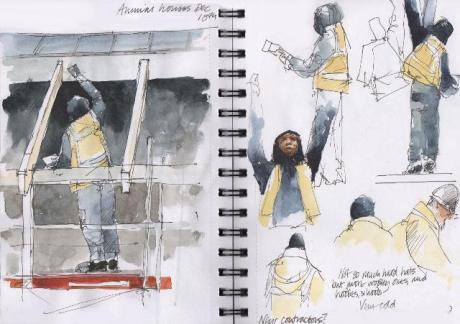Back in the summer while work on the restoration project was still in the building phase, children from several primary schools in Keighley put together a collection of objects – newspaper cuttings, coins, stamps, things they’d written – to seal up inside a time-capsule to be buried under the Norfolk Island Pine beneath the dome in the glasshouses.

Ingeniously constructed from sections of drainpipe it looked very impressive, but it didn’t get buried at the time as the glasshouses were then still a building site. However last week it was carefully placed in a hole dug and prepared for it, and covered over and completed with a stone plaque instructing that it should not be reopened before June 2067.
I Iove time-capsules. When my sister and I were children we used to write notes and hide them in the house whenever we could. Not long ago one turned up behind the bath panel where it had been walled up for 50 years, and the current owners of the house were delighted with it and managed to contact us and send it on. The whole idea of walling something up or burying it so that at some distant time it will be discovered and explored by someone living in the future feels a bit like time-travel, and it fascinates me. All through the excavation and demolition phases of the restoration at Cliffe Castle we were hoping that we just might unearth a buried or hidden message, a Butterfield time-treasure purposely concealed – but nothing came to light.

There were things that had been dropped by accident or thrown away – a milk-bottle, a couple of Victorian coins, jugs and jars and pieces of pottery and numerous mysterious rusty metal objects that were hard to identify, and all their stories remain tantalisingly untold.

All this got me thinking what I would put in a time-capsule if I were to make one now, and it would certainly be drawings, or whole sketchbooks. I often feel that sketches are frozen moments in time, almost like fossils. They record the moment something happened and how I saw it, what it meant and how it felt – something that passed through me and ended up on a piece of paper.

During the path-laying phase every day ended with a lot of clearing up with brooms and shovels, and since drawing people moving is so difficult but such fun I tried to sketch this action, and mostly with disastrous results. This time I think I caught something – but not without absurd anatomical mistakes

The delicate operation of guiding the dome into place on top of the glasshouse. It was a hugely challenging thing to draw because the crane was so enormous, there was so much going on and it all happened fairly quickly – but I couldn’t miss the chance to see what I could get on the page. I certainly remember what went on better from having sketched it – even if this meant focusing on some things and missing others.
I suppose you could say that this whole project, Drawing The Work – and the posts on this blog – are a kind of time-capsule, except of course that they’re not buried or hidden; the posts will stay here for anyone to see.

Some of the visitors at one of the Heritage Walks, listening to Claire pointing out features and explaining the building work. I love sketching people when they’re engrossed in looking and listening because they’re unselfconscious and much more interesting to draw.
The work of the restoration is now almost finished, and from now on, my sketching will be more about life in the park rather than the work of restoring it. A big celebration to mark the completion is going to take place in the park and museum shortly before Christmas on December 10th. The exhibition of Drawing The Work goes on in the museum until January, and we’ve produced greetings cards using a selection of my sketches which will be on sale at the Christmas celebration and in the museum shop.
My Cliffe Castle posts here will now mostly be under the heading Life In The Landscape, and I’m looking forward to a whole new programme of sketching possibilities. Hope you’ll follow me on the adventure!






























